Advertisement
Grab your lab coat. Let's get started
Welcome!
Welcome!
Create an account below to get 6 C&EN articles per month, receive newsletters and more - all free.
It seems this is your first time logging in online. Please enter the following information to continue.
As an ACS member you automatically get access to this site. All we need is few more details to create your reading experience.
Not you? Sign in with a different account.
Not you? Sign in with a different account.
ERROR 1
ERROR 1
ERROR 2
ERROR 2
ERROR 2
ERROR 2
ERROR 2
Password and Confirm password must match.
If you have an ACS member number, please enter it here so we can link this account to your membership. (optional)
ERROR 2
ACS values your privacy. By submitting your information, you are gaining access to C&EN and subscribing to our weekly newsletter. We use the information you provide to make your reading experience better, and we will never sell your data to third party members.
Environment
Red Fireworks Go Green
Environmental Science: Ditching chlorine-based ingredients in red pyrotechnics avoids the production of carcinogenic chemicals in the fallout
by Sarah Everts
August 27, 2015
| A version of this story appeared in
Volume 93, Issue 34
Créditos: Shutterstock

Makers of fireworks and flares have long believed that the beautiful red color in their explosions could be attained only with chlorine-based compounds. But after these ingredients combust, they can transform into cancer-causing chemicals that then fall to the ground.
Now, new chlorine-free pyrotechnics could pave the way for a generation of red fireworks and flares that are better for the environment and for people’s health, says Jesse J. Sabatini at the U.S. Army Research Laboratory, in Maryland. Sabatini developed the red pyrotechnics with Ernst-Christian Koch at consulting firm Lutradyn, in Kaiserslautern, Germany (Angew. Chem. Int. Ed. 2015, DOI: 10.1002/anie.201505829).
Currently, red fireworks get their hue primarily from strontium monochloride, which is produced by burning strontium compounds with polyvinyl chloride and a variety of other pyrotechnics ingredients. But the combustion of these mixtures produces a variety of polychlorinated aromatic chemicals, including some potent carcinogens.
To make more environmentally friendly fireworks, the researchers focused on strontium monohydroxide, a compound long believed to be only a minor contributor to the red color of pyrotechnics. According to Koch, for years, scientists hadn’t realized that strontium monohydroxide also strongly flared red because its sister product, strontium oxide, produces an orange-red color that fireworks-makers try to avoid.
Sabatini, Koch, and coworkers formulated the new explosive by replacing polyvinyl chloride on the old ingredient list with either hexamine, a preservative in citrus washing solutions, or 5-amino-1H-tetrazole, an air-bag propellant. The replacement sidesteps chlorine and produces strontium monohydroxide when the overall concoction is ignited, resulting in bright red fireworks.
The potential benefit is not just to those putting on Fourth of July and New Year’s Eve fireworks displays, comments David E. Chavez, a chemist at Los Alamos National Laboratory. The military is also a large consumer of red flares, particularly for training purposes. “Training areas get fallout [from flares] over and over again,” he says. So much so “that it can be an issue for environmental clean-up,” Chavez adds.
This article has been translated into Spanish by Divulgame.org and can be found here.





Join the conversation
Contact the reporter
Submit a Letter to the Editor for publication
Engage with us on Twitter